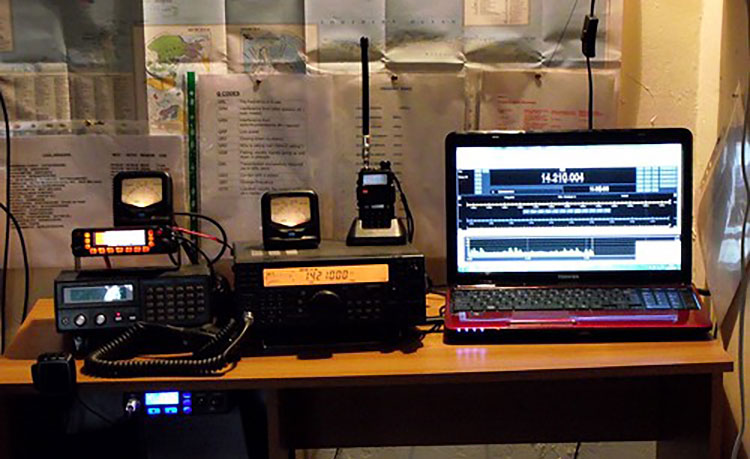
Many ham radio operators look for ways to disguise or hide otherwise large radio antennas. A stealth antenna is any antenna that cannot be readily seen. We’ll cover how to hide such an antenna in this article.
Why a Stealth Antenna
Some people need to hide a ham radio antenna in order to comply with home owners association rules. If you’re a prepper, maybe you just want to hide one to maintain OPSEC.
You live in an apartment, understand the importance of prepping, and have taken steps to improve your post-disaster communications ability as well. While you fully understand the importance the antenna plays with the range you can have with ham radio, you also are concerned about keeping a low profile. After all, we know what happened to the main characters in The Shelter when their neighbors knew about their home fallout shelter and the sirens then sounded.
Maybe you don’t even face those issues at all, it’s just the idea of having a large antenna attached to the outside of your antenna is not appealing to you in the least. Perhaps it’s aesthetically displeasing. Maybe your spouse objects.
And though you’ve seen the schematics available online for tacking a large wire antenna around the ceiling of a room to function as a makeshift antenna, you’re not a fan of that method either. For starters, you believe it looks incredibly tacky. Secondly, any guest that ever visits that room is immediately going to question why it is there, what it is for, and so on.
If you live in a country somewhere within the Middle East or Asia, the sight of an antenna can easily lead authorities to deduce you are most likely a spy and therefore must be treated accordingly. This can be a very scary proposition that is best avoided altogether by limiting one’s ham “signature.”
For whatever reason(s), you like to keep your ham radio endeavors as secret as possible, and thus, you need an alternative.
I want to show you a way to easily construct an antenna within your home which is discrete, can quickly be taken down (and put up) should disaster necessitate so, will drastically expand the range of your ham radio communications/intelligence efforts, is easily portable within a bug-out bag, and that won’t break the bank either.
Sounds like the total package, doesn’t it? Let’s take a look.
Equipment I’ll Be Using
You’re going to need to make some basic purchases here before beginning. It’s possible you may already have some of these items on-hand, which will save some costs, but regardless, many of these items are not that expensive from the outset.
1) A Yaesu VX-6R
This is easily one of the best ham radios out there (read my review of it). Of course, you don’t have to use this exact radio, any comparable radio will do, it’s just the radio I’m using.
- Yaesu 264-2M/70CM 5W 220 1.5W DUAL BAND HT
- Ham Guides TM Pocket Reference Card Bundle
Don’t forget the programming software!
2) A Slimline J-Pole Antenna
You can find this devise by clicking here. Note – if you buy this piece you will not need the adapter listed further below.
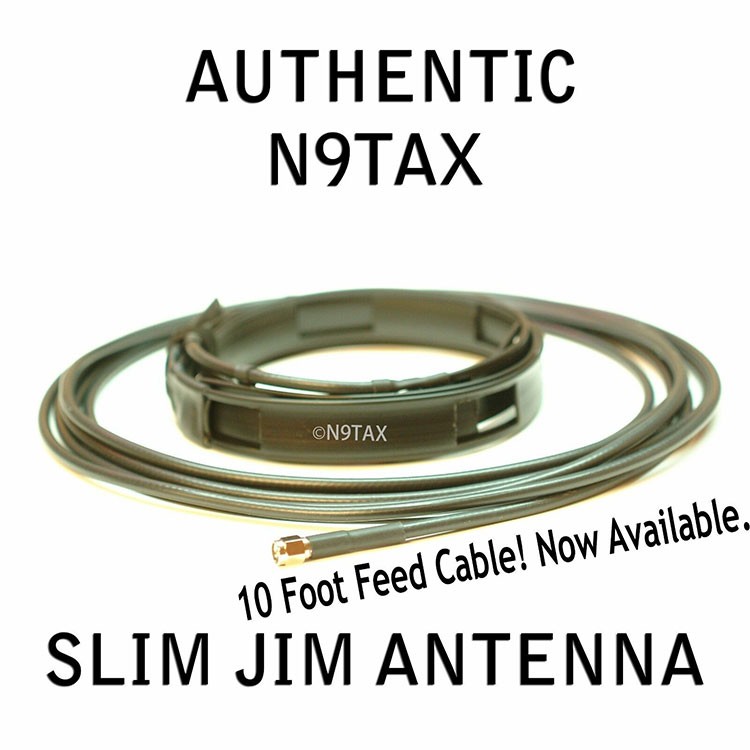
3) An Adapter
You need an adapter that connects the coaxial cable (antenna) to the radio itself. Note – if you bought the Slim Jim antenna above you will not need this adapter.
- ➦CONNECTOR - UHF Female (center hole) and SMA Male (center pin) │Impedance: 50 ohm│Temp.range: -65~ +165℃(PE Cable -~ +85 ℃)│Insulation resistance: 5000MΩ.
- ➦APPLICATION - UHF Female to SMA Male Adapter/Converter. Connect Baofeng Radios to Base Station Antenna. Used widely at UHF,VHF Frequency Connect and Radio Station Antenna Convertion
4) A Loop of Fishing Line
This is easy enough to procure, you likely have some sitting around somewhere, but you can also use something else for tying off the cable (see installation steps below).
5) A Small Screw-In ‘J’ Hook
You may also have one of these somewhere in your garage. You can order them on Amazon or buy them at your local hardware store.
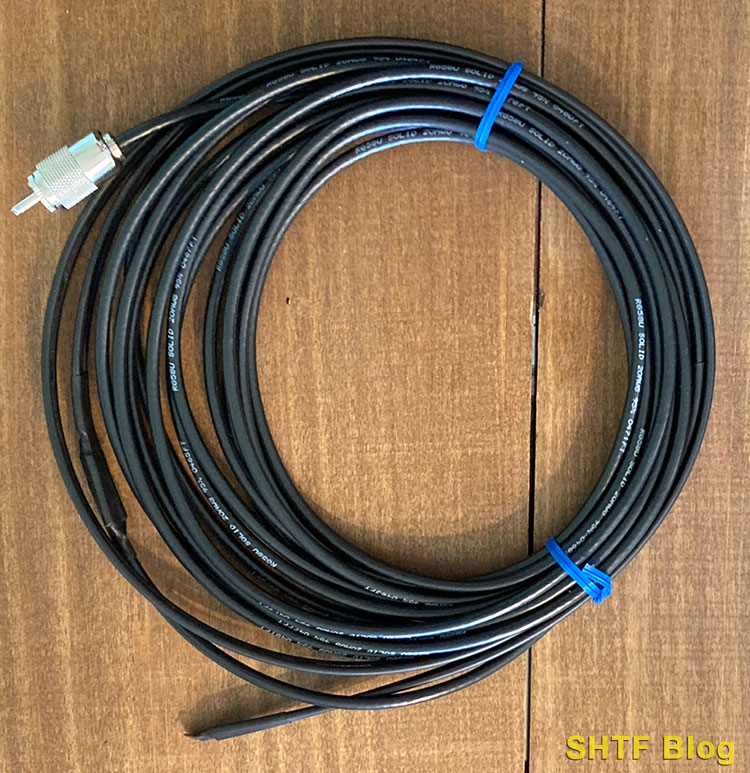
If you have all this equipment, you’re good to go.
4 Steps to Installing a Hidden Ham Radio Antenna
Now that you have assembled the necessary parts, you have to fish your coaxial cable (antenna) through your house to gain maximum exposure and reception.
Step 1: Use the Fishing Line
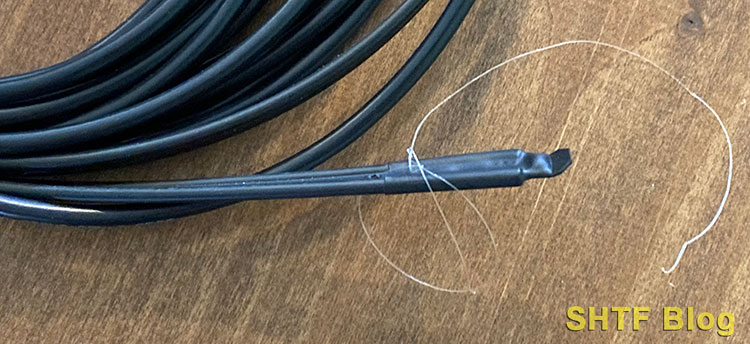
This is as easy as it gets. Take a little piece of fishing line about 8” long, thread it through the hole at the end of your J-pole antenna and tie the fishing line in a loop. You now have an effective anchor point that will keep your antenna firmly in place.
Step 2: Screw the ‘J’ Hook in a Discrete Part of Your Ceiling
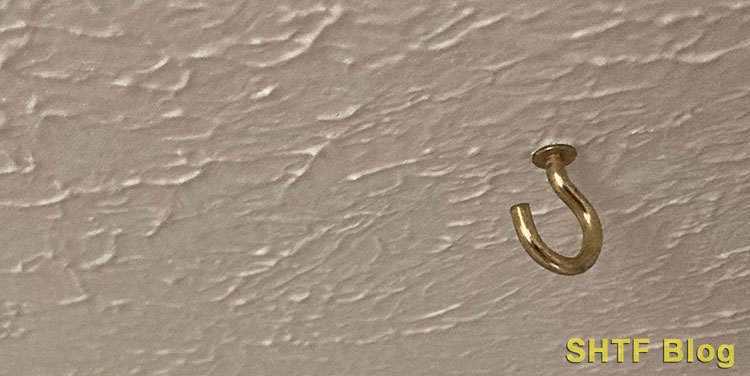
I recommend doing this well away from ceiling fans. If the hook is in the corner of a room, anybody who does happen to see it will simply assume it is there for decorative purposes (e.g. to hang a wall decoration or the like).
It may be harder to explain away a hook that’s left in the middle of the ceiling of a room which guests are likely to enter, though if you’ve used the hook in the past for Christmas lights, birthday decorations, or the like, you’ll have an easy excuse here.
However, it’s not as if this hook has to be a permanent fixture within your house. You could easily unscrew it and tuck it away for later after you are through using your radio.
Keep in mind that the higher your antenna is, the better your post-disaster comms will be. Thus, a ceiling on the second floor of your house is better suited to this antenna than the ceiling within your basement would be.
Step 3: Hang the ‘J’ Pole Antenna from the ‘J’ Hook
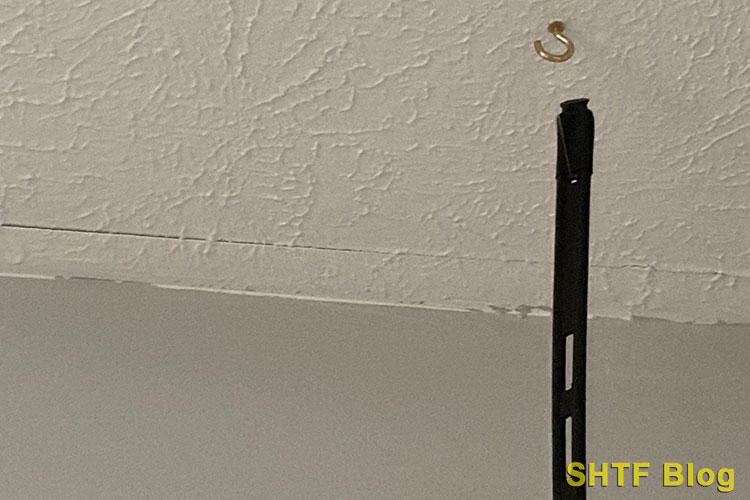
Take that little loop of fishing string you tied earlier and hang it over the little hook. This will hold it up and in place.
Step 4: Attach the J-Pole Antenna to Your Radio
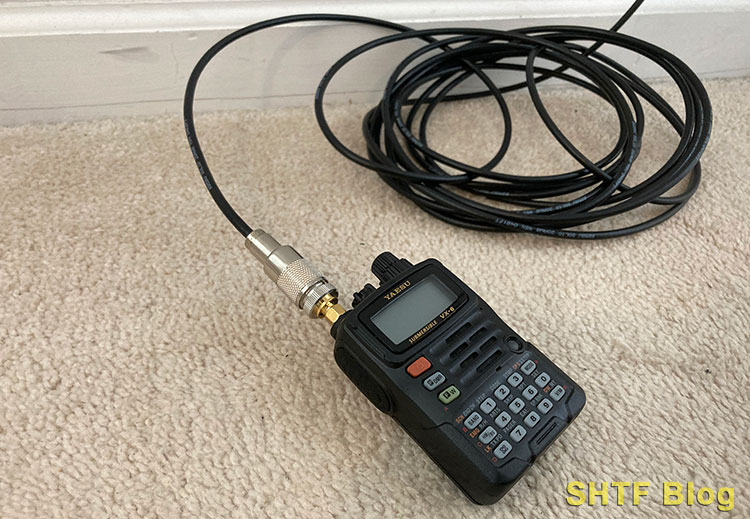
You’ll likely have to use an adapter to do such but screw the radio onto the antenna. That’s all there is to it! You now have a great means of communication for disaster purposes!
How Good of an Antenna is This?
Most handheld ham radios (referred to as HTs within the ham world) come with a stock antenna (referred to as a ‘rubber duck’) that’s absolutely terrible. They barely will allow you to transmit anywhere, and your ability to receive transmissions will be severely limited.
This is why one of the first updates you should make to your ham radio should be to the antenna. Though I don’t have hard and fast data on this, through conversations with retired electrical engineers/hams, my understanding is that this rig could easily give you three times the range as the rubber duck that comes standardized on your radio.
That’s a big deal!
This Hidden Antenna is Portable
Let’s say that it’s a WROL world. There are enemies in your midst wanting to steal your stored cans of SPAM.
Then you hear a heavy diesel engine outside. Peeking out your window, you see a party of hungry thugs in front of your apartment. It’s time to go, and it’s time to go now.
This antenna is perfect for a quick bug out. Just take down the antenna, unhook everything, and throw it in you bug out bag in all of 1 minute 32 seconds. This means you could get the heck out of dodge with all my necessary equipment (yes, I do consider radio equipment necessary for a WROL scenario) in minimal time.
Easy to Fit in a Bug Out Bag
How much space will this antenna take up in a bug out bag? Not much!
I mean, check it out. It fits in this BOB here just fine.
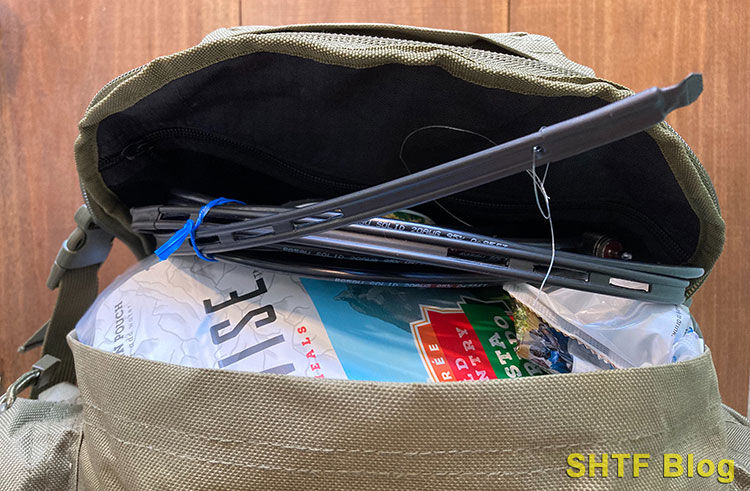
It’s not a heavy setup either. Weight-wise, the entire kit probably weighs somewhere around 2-3 pounds.
Works Great Outdoors as Well
Now let’s say you’ve grabbed your BOB with your radio gear, bolted out the door, and are booking it toward the woods as you hear doors slamming shut from the vehicle in front of your home. You don’t stop running until about an hour later, when you judge you’re 3-4 miles from your house.
However, you need to know if distant family signal. Would this antenna setup work even then? Yep, sure would!
Let’s look at how to do this.
Step 1: Tie a Length of Paracord to the Loop of Fishing String
Easy. Not much to explain here.
Step 2: Tie the Other End of the Paracord to a Rock Or Small Log
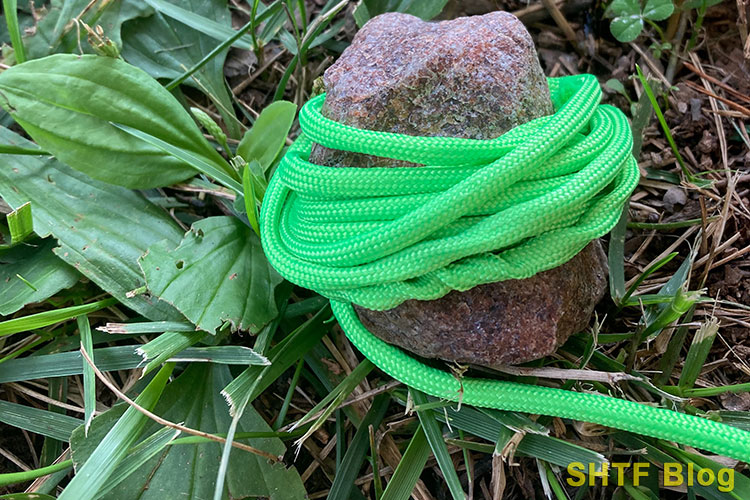
If you need me to explain this step… well.
Step 3: Throw the Rock/Stick Over a Nearby Branch
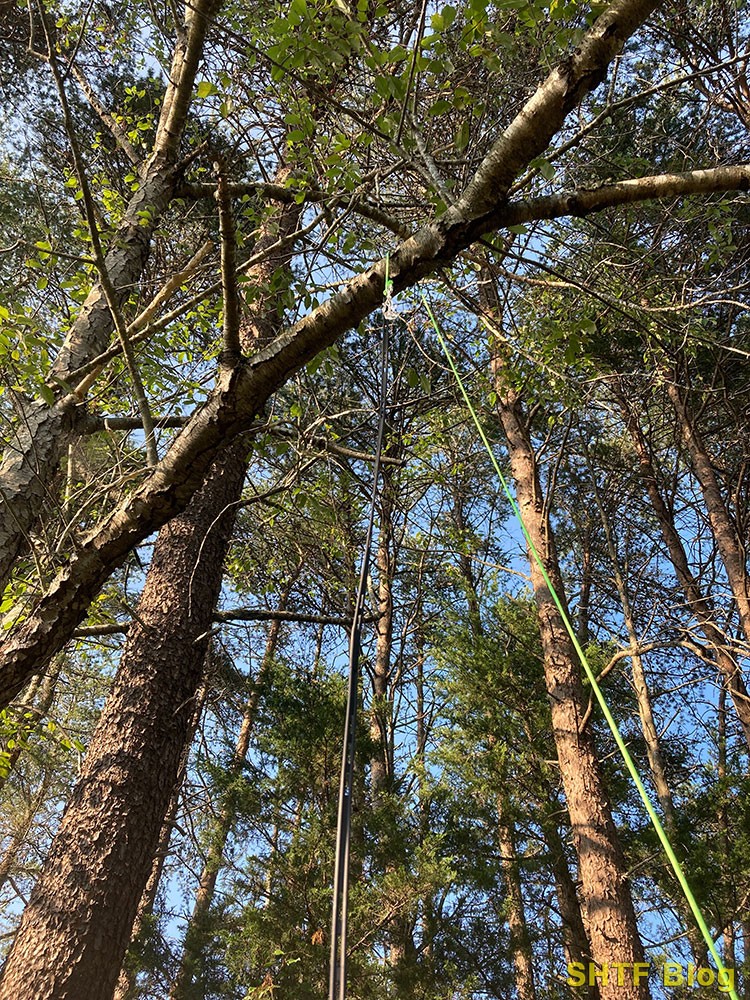
This will get the paracord up and over a branch. Pull on the rock end of the rope to raise the antenna up and into the trees. Once it’s at a height you’re happy with, drop the rock, and you’re good to go. (Don’t transmit with this antenna in such an environment. Directional antennas would be much safer for such a scenario.)
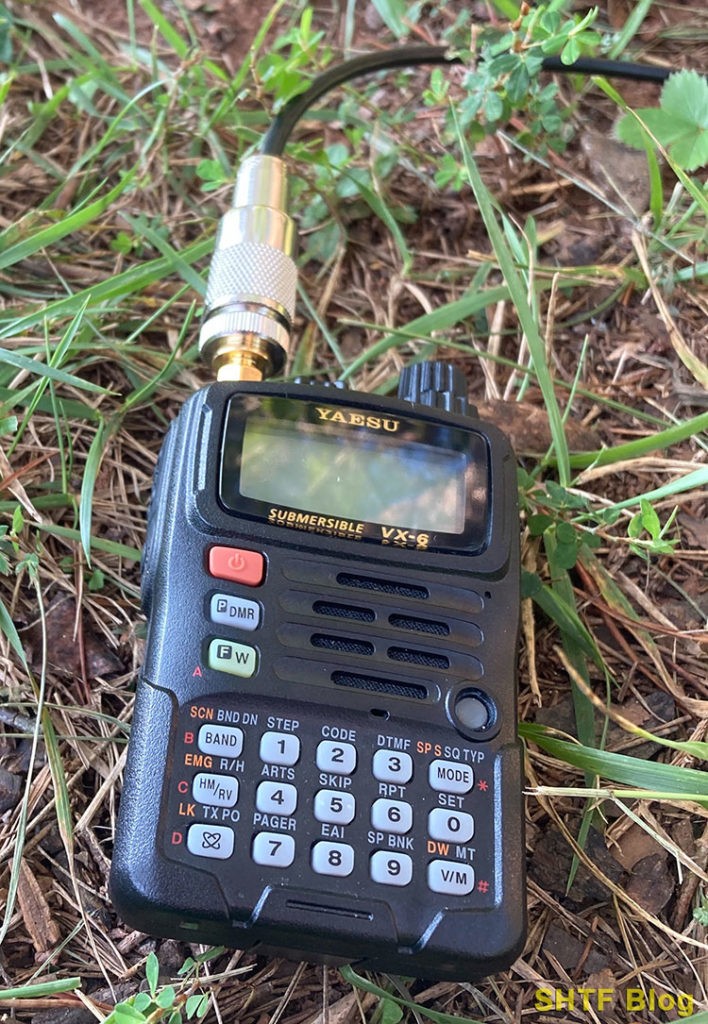
Signing Off
This is an easy and affordable means of keeping your ability to send and receive ham radio messages even when you’re not in a home where you can set up a big antenna on the outside of your home. If you find yourself in a crunch for money, a need for a BOB antenna set up, or searching for a way to increase your communication abilities in your apartment, I highly recommend trying this method.
I think you’ll find a lot of value in it, and it’ll greatly increase your abilities to both transmit and receive information in a post-disaster environment.
What are your thoughts on the system? Are there potential pitfalls you can see? Other benefits we didn’t list above? Are there different systems out there you use? Let us know in the comments below!




3 comments
Wondering how this would work underneath the floor (post and pier)…any ideas?
You’d have to try it to find out, but probably not great. Can you run it through the attic?
Going to try this antenna with my HT as well as my 25w mobile/solar toolbox setup.